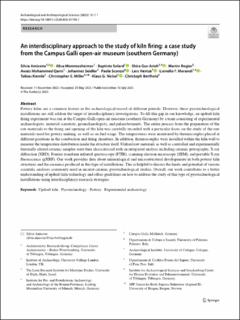| dc.contributor.author | Amicone, Silvia | |
| dc.contributor.author | Memmesheimer, Alisa | |
| dc.contributor.author | Solard, Baptiste | |
| dc.contributor.author | Gur-Arieh, Shira | |
| dc.contributor.author | Rogier, Martin | |
| dc.contributor.author | Qarni, Awais Mohammed | |
| dc.contributor.author | Seidler, Johannes | |
| dc.contributor.author | Sconzo, Paola | |
| dc.contributor.author | Heinze, Lars | |
| dc.contributor.author | Morandi, Lionello F. | |
| dc.contributor.author | Kiemle, Tobias | |
| dc.contributor.author | Miller, Christopher | |
| dc.contributor.author | Nickel, Klaus G. | |
| dc.contributor.author | Berthold, Christoph | |
| dc.date.accessioned | 2024-04-19T11:24:42Z | |
| dc.date.available | 2024-04-19T11:24:42Z | |
| dc.date.created | 2023-09-06T13:56:55Z | |
| dc.date.issued | 2023 | |
| dc.identifier.issn | 1866-9557 | |
| dc.identifier.uri | https://hdl.handle.net/11250/3127430 | |
| dc.description.abstract | Pottery kilns are a common feature in the archaeological record of different periods. However, these pyrotechnological installations are still seldom the target of interdisciplinary investigations. To fill this gap in our knowledge, an updraft kiln firing experiment was run at the Campus Galli open-air museum (southern Germany) by a team consisting of experimental archaeologists, material scientists, geoarchaeologists, and palaeobotanists. The entire process from the preparation of the raw materials to the firing and opening of the kiln was carefully recorded with a particular focus on the study of the raw materials used for pottery making, as well as on fuel usage. The temperatures were monitored by thermocouples placed at different positions in the combustion and firing chambers. In addition, thermocouples were installed within the kiln wall to measure the temperature distribution inside the structure itself. Unfired raw materials as well as controlled and experimentally thermally altered ceramic samples were then characterised with an integrated analysis including ceramic petrography, X-ray diffraction (XRD), Fourier transform infrared spectroscopy (FTIR), scanning electron microscopy (SEM), and portable X-ray fluorescence (pXRF). Our work provides data about mineralogical and microstructural developments in both pottery kiln structures and the ceramics produced in this type of installations. This is helpful to discuss the limits and potential of various scientific analyses commonly used in ancient ceramic pyrotechnological studies. Overall, our work contributes to a better understanding of updraft kiln technology and offers guidelines on how to address the study of this type of pyrotechnological installations using interdisciplinary research strategies. | en_US |
| dc.language.iso | eng | en_US |
| dc.publisher | Springer | en_US |
| dc.rights | Navngivelse 4.0 Internasjonal | * |
| dc.rights.uri | http://creativecommons.org/licenses/by/4.0/deed.no | * |
| dc.title | An interdisciplinary approach to the study of kiln firing: a case study from the Campus Galli open-air museum (southern Germany) | en_US |
| dc.type | Journal article | en_US |
| dc.type | Peer reviewed | en_US |
| dc.description.version | publishedVersion | en_US |
| dc.rights.holder | Copyright 2023 The Author(s) | en_US |
| dc.source.articlenumber | 111 | en_US |
| cristin.ispublished | true | |
| cristin.fulltext | original | |
| cristin.qualitycode | 1 | |
| dc.identifier.doi | 10.1007/s12520-023-01798-1 | |
| dc.identifier.cristin | 2172944 | |
| dc.source.journal | Archaeological and Anthropological Sciences | en_US |
| dc.relation.project | Norges forskningsråd: 262618 | en_US |
| dc.identifier.citation | Archaeological and Anthropological Sciences. 2023, 15 (8), 111. | en_US |
| dc.source.volume | 15 | en_US |
| dc.source.issue | 8 | en_US |

